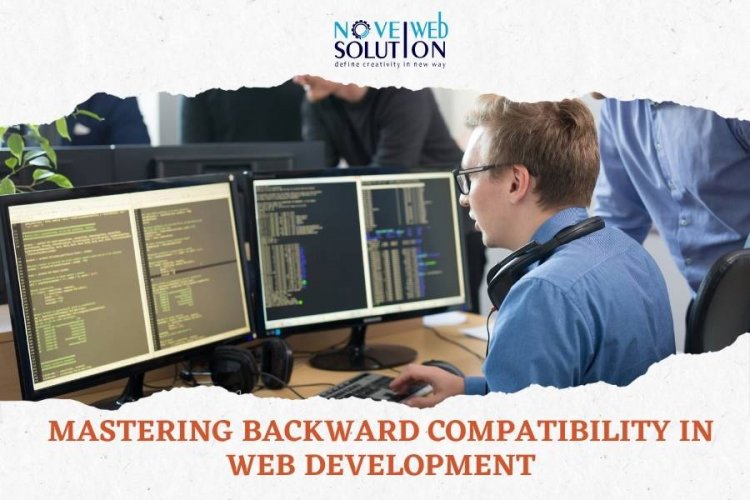Mastering Backward Compatibility in Web Development

In today’s fast-paced world of web development, staying ahead of the technological curve is essential. However, one crucial aspect often overlooked by developers is backward compatibility. Backward compatibility ensures that new web applications or websites work seamlessly with older browsers, devices, and operating systems, providing a consistent user experience across diverse platforms. For businesses and developers in Jaipur and beyond, understanding the importance of backward compatibility is key to retaining user satisfaction and expanding reach.
What is Backward Compatibility?
Backward compatibility refers to the ability of newer software, technologies, or websites to work well with older versions of browsers or devices. For web development, it means ensuring that websites function correctly and efficiently across older versions of browsers like Internet Explorer, older mobile devices, and even outdated operating systems. Without backward compatibility, users might encounter broken layouts, slow performance, or features that don’t work at all, leading to frustration and high bounce rates.
Why Backward Compatibility Matters in Web Development?
Improved User Experience
A website that functions seamlessly across all devices and browsers, whether modern or outdated, guarantees a positive UX Desgin (user experience). Websites that don’t support older devices or browsers could alienate a portion of potential users, especially those who still use older technology due to personal preference or budget constraints.
Wider Audience Reach
Many users still rely on older operating systems or browsers, particularly in emerging markets or regions with limited access to the latest technology. Ensuring backward compatibility helps developers tap into this audience, increasing website traffic and improving engagement. For businesses, this expanded reach could mean more conversions and sales.
SEO Benefits
Search engines, like Google, consider user experience and mobile-friendliness when ranking websites. A website that doesn’t work well on older devices or browsers will likely have a higher bounce rate, which can hurt its SEO performance with the help of seo company. On the other hand, websites that support backward compatibility are more likely to rank higher in search engine results, enhancing their visibility.
Cost-Effectiveness
Updating your website to be backward compatible might require an initial investment in time and resources. However, this can save significant costs in the long run. If your website fails to work properly for a subset of users, you risk losing them, leading to costly redesigns or marketing efforts to regain their attention.
How to Ensure Backward Compatibility in Web Development?
Use Progressive Enhancement
Progressive enhancement is a web development strategy that ensures a website’s core content and functionality are accessible to everyone, regardless of the technology they are using. For users with older browsers or devices, they will still experience a functional version of the website, albeit with fewer features. However, those with newer technology will enjoy the full, feature-rich experience.
Cross-Browser Testing
Cross-browser testing is one of the most effective ways to ensure backward compatibility. By testing a website on various browsers (including older versions of popular ones like Chrome, Firefox, Safari, and Internet Explorer), developers can identify compatibility issues and address them before the website goes live. Automated tools like BrowserStack and Sauce Labs make cross-browser testing easier and more efficient.
Responsive Design
A responsive web design ensures that a website adjusts its layout and content to fit different screen sizes, from desktop computers to mobile devices. By adopting a mobile-first approach and using responsive design frameworks like Bootstrap or Foundation, developers can ensure that websites are compatible with a variety of devices, including older smartphones and tablets.
Graceful Degradation
While progressive enhancement focuses on ensuring core features work for all users, graceful degradation ensures that websites still function on older systems, even if they lack certain modern features. For example, a website might have advanced CSS animations that are not supported on older browsers. With graceful degradation, these animations would simply be skipped, ensuring the website remains functional.
Hire Web Development Company in Jaipur
Hiring a reputable website development company is vital for companies in Jaipur that need to build websites that appeal to a wide range of online customers. A professional website development team in Jaipur will have the expertise to implement backward compatibility strategies, such as progressive enhancement, cross-browser testing, and responsive design.
Choosing a local website development company ensures that you get tailored solutions that meet the specific needs of your target audience. Whether you are looking to improve your website’s accessibility for older browsers or optimize it for mobile devices, A reputable rajasthan web developing company can give you the expertise and assets you need to create an optimal user experience for everyone.
Conclusion
Mastering backward compatibility is not just a technical challenge but an essential part of creating a user-friendly, accessible, and successful web presence. By focusing on backward compatibility, you can ensure that your website serves a wider audience, enhances user experience, and boosts your SEO rankings. Whether you are in Jaipur or elsewhere, working with a skilled website development company can help you achieve a seamless, future-proof website that stands the test of time and technology.






